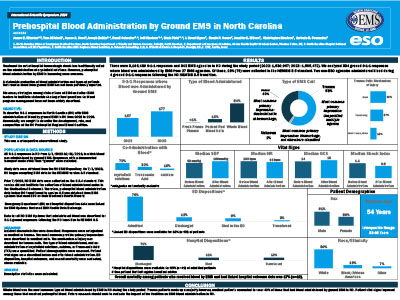ABSTRACTS
Prehospital Whole Blood ParadoxAuthor: David Grovdahl, Amanda Armstrong, Stephanie Carhart, Collier Reeves, Sara E. Houston, Michael W. Hubble, and Ginny R. Kaplan | | Associate Authors:
Introduction: Traumatic hemorrhage is a leading cause of death in the United States. A recent study found that whole blood (WB) administration to severely injured adult trauma patients after 1 hour of hospital arrival is associated with increased morbidity. Time of injury to hospital arrival can often exceed 45 minutes, placing patients outside of this beneficial window. Prehospital clinicians are uniquely positioned to reduce the time to WB administration. Objective: To determine a quantifiable population of prehospital patients who would benefit from readily accessible prehospital WB administration. Methods: A retrospective analysis was conducted using the 2020 ESO Data Collaborative. The dataset included all adult (> 18 years) trauma patients with a prehospital shock index > 1. A 15-minute buffer was allotted for in-hospital WB administration, leaving 45 minutes for the Public Safety Answering Point (PSAP)-to-hospital arrival interval using Center for Medicare/Medicaid Services (CMS) urbanicity districts. Descriptive statistics were calculated and chi-square analyses were conducted. Results: A total of 27,715 patients met inclusion criteria. The distribution of adult trauma patients by CMS urbanicity district was 21,800 (78.65%), 4832 (17.43%), and 1083 (4.97%) for urban, rural, and super-rural districts, respectively. In urban areas, 6430 (29.5%) of patients had a PSAP-to-hospital arrival interval ≥ 45 minutes, corresponding values in rural areas and super-rural areas were 2189 (45.3%) and 637 (58.8%) patients, respectively (p < .01). Results indicate that arrival to hospital in ≤ 45 minutes was considerably higher in urban areas compared to other urbanicity designations. In contrast, PSAP-to-hospital arrival intervals ≥ 45 minutes were more common in super-rural areas. Conclusion: Based on these results, there is a quantifiable population of patients who could potentially benefit from prehospital WB administration. These patients are disproportionately located in rural and super-rural areas where prehospital blood transfusion is less likely to be available. More research is needed to determine the utility of WB administration in the prehospital environment.
|

